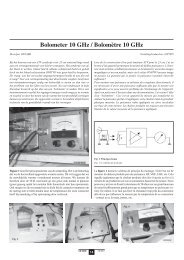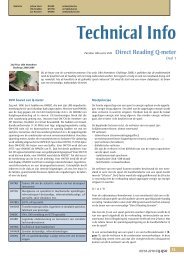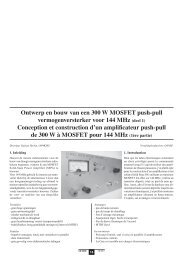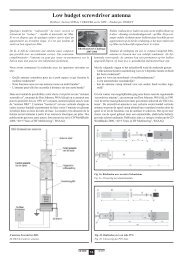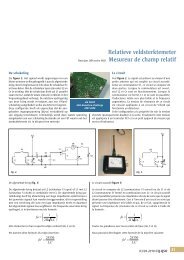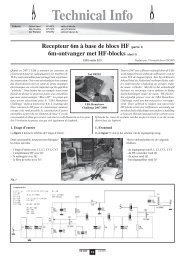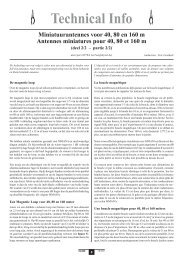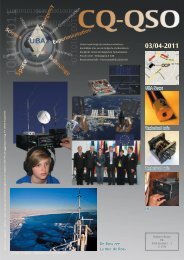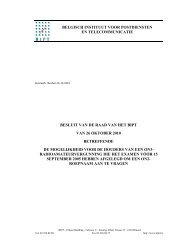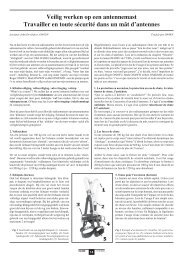IARU Region 1 VHF Managers Handbook - UBA
IARU Region 1 VHF Managers Handbook - UBA
IARU Region 1 VHF Managers Handbook - UBA
You also want an ePaper? Increase the reach of your titles
YUMPU automatically turns print PDFs into web optimized ePapers that Google loves.
• As a few authorities in the European part of <strong>Region</strong> I have allowed some amateur activity in the<br />
50 MHz part of the spectrum, societies are urged to again approach their P & T authorities with<br />
the aim of obtaining an allocation or assignment preferably between 50 and 55 MHz. In view of<br />
the TV activity still present in this part of the spectrum, in the first instance permission may be<br />
sought for operation outside TV broadcast hours, e.g. for experimental purposes for a selected<br />
number of stations.<br />
A further recommendation regarding the 50 MHz band was adopted at the meeting of the <strong>IARU</strong> <strong>Region</strong> 1<br />
<strong>VHF</strong>/UHF/Microwaves Committee in Vienna, March 1992, and accepted as interim <strong>IARU</strong> <strong>Region</strong> 1 policy<br />
by the <strong>IARU</strong> <strong>Region</strong> 1 Executive Committee at their meeting in Budapest, April 1992. This<br />
recommendation was ratified at the <strong>IARU</strong> <strong>Region</strong> 1 Conference in De Haan (1993) and reads:<br />
All <strong>IARU</strong> <strong>Region</strong> 1 member societies in countries where the Amateur Service is currently not<br />
permitted to use the 50 MHz band shall endeavour to obtain such a permission in the 50 - 54 MHz<br />
band. This permission should preferably be permanent and under the same conditions as valid for<br />
the normal licences. In order to obtain a common <strong>IARU</strong> <strong>Region</strong> 1 band, the allocation band<br />
obtained should at least contain the frequency segment 50 - 50.5 MHz.<br />
At the meeting of the <strong>IARU</strong> <strong>Region</strong> 1 <strong>VHF</strong>/UHF/Microwaves Committee in Düsseldorf (1989) the following<br />
recommendation regarding the shared microwave bands was adopted and a few weeks later approved as<br />
interim <strong>IARU</strong> <strong>Region</strong> 1 policy by the <strong>IARU</strong> <strong>Region</strong> 1 Executive Committee at their meeting in Torremolinos,<br />
April 1989. The <strong>IARU</strong> <strong>Region</strong> 1 Conference at Torremolinos, April 1990, ratified this recommendation:<br />
• <strong>IARU</strong> and <strong>IARU</strong> <strong>Region</strong> 1 should maintain their basic policy of trying to retain all wideband secondary<br />
allocations in the Microwave bands.<br />
• Note. This <strong>IARU</strong> policy is clearly set out in paper C3.35, submitted to the <strong>IARU</strong> <strong>Region</strong> 1 Conference<br />
at De Haan (1993) by the International Secretariat of <strong>IARU</strong>. At this Conference the paper (see 1.3.1.)<br />
was adopted by <strong>IARU</strong> <strong>Region</strong> 1.<br />
However, <strong>IARU</strong> and <strong>IARU</strong> <strong>Region</strong> 1 should also endeavour to convince Administrations that in all<br />
countries the same small region-wide common segments - in the order of 2 MHz wide - should be<br />
allocated to the Amateur Service, as commonality is a practical necessity for international amateur<br />
activities.<br />
N.B. Already at the <strong>IARU</strong> <strong>Region</strong> 1 Conference in Noordwijkerhout (April 1987) <strong>IARU</strong> <strong>Region</strong> 1<br />
nominated a <strong>VHF</strong>/UHF/Microwave Frequency Allocation Coordinator (see section Id). His terms of<br />
reference include carrying out the work mentioned above in behalf of <strong>IARU</strong> <strong>Region</strong> 1.<br />
At the WARC in Torremolinos (1990) the status of the Mobile Service in the frequency segment 2300 -<br />
2450 MHz was upgraded to Primary (see Frequency Allocation Tables). The Mobile Service and the<br />
Amateur Services must be considered to be practically incompatible, as far as the use of frequencies is<br />
concerned. Hence <strong>IARU</strong> <strong>Region</strong> 1 is making vigourous efforts - via approaches by member societies to<br />
Administrations, as well as indirect approaches to, for instance, the CEPT - to get a reasonable and<br />
common part of this frequency segment de facto or de jure exclusively allocated to the Amateur Service.<br />
Within CEPT an large programme has been initiated from 1993 onwards to create a harmonised European<br />
frequency table. Detailed Spectrum Investigations ( DSI ) have been arranged and <strong>IARU</strong> <strong>Region</strong> 1 and its<br />
member societies have actively contributed to those studies. In the microwave bands this has led to<br />
retention of the existing allocations in the ITU table and in addition to a recommmendation that<br />
administrations should allocate spectrum in the 3400-3500 MHz band to their amateurs. Moreover the<br />
concept of virtually exclusive narrow segments in the microwave bands has been recognised by the<br />
CEPT.<br />
Currently amateurs in 4X, 5B, 9A, OH, OK, OZ and PA have got access to 3400-3410 MHz in addition to<br />
the (ITU footnote ) allocations in Bulgaria, Norway, Poland, Germany, Slovenia and Great Britain.<br />
<strong>IARU</strong> <strong>Region</strong> 1 page 13/148 Version 5.40<br />
<strong>VHF</strong> managers handbook




